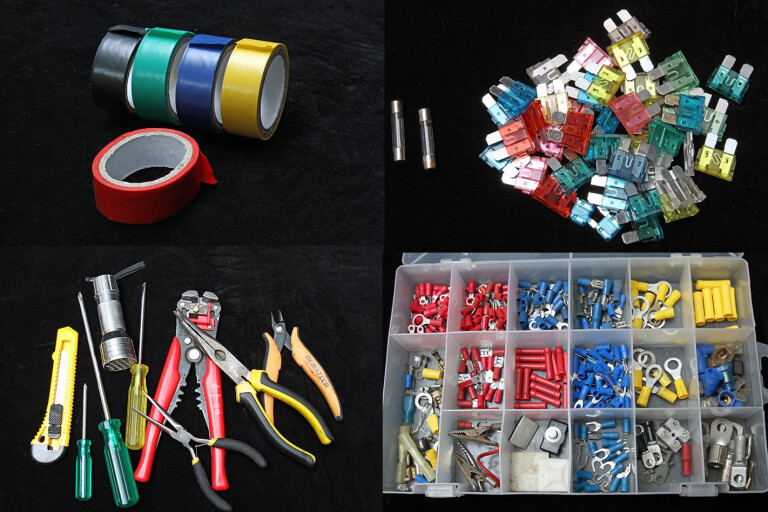
Every four-wheel driver who doesn’t use the car solely to pick up the kids after school understands the importance of going into remote areas well prepared for whatever might come along.
This article was first published in 4x4 Australia's May 2013 magazine.
On those long trips up the gibber trails, across dry mud pans and down the face of yellow dunes the storage tubs and rear drawers are bursting with every conceivable spare and tool that you can carry for the engine, transmission and suspension. But how many people ponder an electronics tool kit?
The what? What spares would you carry? That stuff either works or it doesn’t. If it doesn’t then someone else might know enough to bodgey a repair and get it into the nearest workshop. Well, if that’s your attitude you’re likely to spend quite a while looking at your dead car out in the mulga at some time.
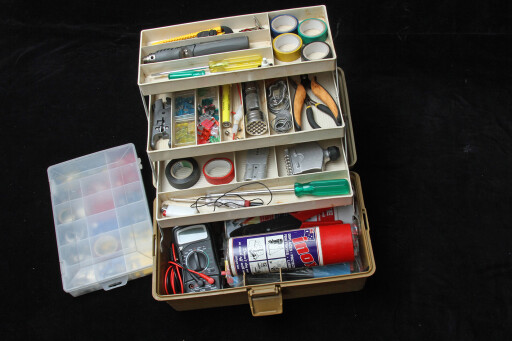 Stuart Peddle is the 4WD specialist for Redarc, one of Australia’s leading automotive electrical product developers, and he recommends a thorough kit that will get you out of the worst emergencies. “It’s always good to be prepared,” he told 4X4, “I carry equipment for all sorts of situations because it might not just be your own vehicle which has a problem, and if you travel in convoy with other vehicles you tend to share resources.
Stuart Peddle is the 4WD specialist for Redarc, one of Australia’s leading automotive electrical product developers, and he recommends a thorough kit that will get you out of the worst emergencies. “It’s always good to be prepared,” he told 4X4, “I carry equipment for all sorts of situations because it might not just be your own vehicle which has a problem, and if you travel in convoy with other vehicles you tend to share resources.
“What I find is – and we get a lot of calls at Redarc on things like the pay phone at Innamincka or somewhere like that – that people can have the best system in the world but when they get out there they can find out that connections and fittings can start to break down on corrugations and under attack from moisture and dust.
“What I recommend is that people take just the basics that they can get away with, along with a fundamental understanding of what their system comprises and how it works. Batteries and 12-volt electronics are a must for us to be out there.”
Here’s Stuart’s kit:
WD40
A can of WD40 or some similar agent (they’re all essentially fish oil with a minor range of additives and will do the same basic job) is probably a man’s best friend when it comes to electrical connections. You can use it to wash out dust, to ensure moisture doesn’t get into things you want to stay dry, to stop corrosion being caused from there on.
 That can be on fuse connections, trailer plugs and all that sorts of things. It’s also useful for a huge range of other jobs when in the bush; don’t leave home without some.
That can be on fuse connections, trailer plugs and all that sorts of things. It’s also useful for a huge range of other jobs when in the bush; don’t leave home without some.
Trailer Plugs
It’s always good to have a quality metal male-side trailer plug. The plastic plugs can be stood on or bent in camp and break up quite easily. The cast aluminium versions are much more robust and if it unplugs itself you have a much better chance of it simply dragging along the ground than if it’s a plastic plug which will certainly break up. Stuart Peddle says he always carries a spare plug just in case.
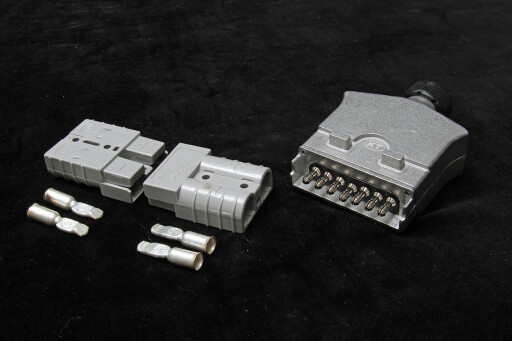 Anderson plugs, for transmitting power from the alternator to a trailer-based battery, only come in plastic and so will be subject to damage if they fall out of the vehicle plug while driving or to other physical damage around camp. Carry a spare is the simple advice (buy genuine Anderson brand, not a cheap clone, as these are prone to corrosion on the connectors which will inhibit electrical efficiency).
Anderson plugs, for transmitting power from the alternator to a trailer-based battery, only come in plastic and so will be subject to damage if they fall out of the vehicle plug while driving or to other physical damage around camp. Carry a spare is the simple advice (buy genuine Anderson brand, not a cheap clone, as these are prone to corrosion on the connectors which will inhibit electrical efficiency).
Small Set of Basic Tools
A small tool set is important for electrical work. Both a Phillips head and a flat blade screwdriver are always important, especially if that trailer plug needs attention. Wire crimps, a pair of pointy nosed pliers and a pair of sidecutters are also always vital; the latter also coming in handy for trimming cable ties, baring wires or crimping a terminal. And don’t forget a small knife and a torch for those dark, out of the way places.
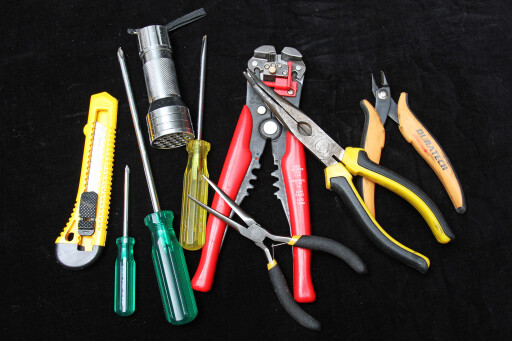 Cable Ties
Cable Ties
A pack of cable ties (aka zip ties) can be amongst your best friends in the bush, and can come in handy electronically for holding wires clear of moving parts, bunching wires together and supporting longer runs of wire. And don’t forget to regularly check zip ties beneath the vehicle to ensure that stones have not broken any off (quite common on gibber tracks) or that heat from the exhaust has not weakened the ties and allowed them to sag and expose the wires to damage.
 Fuses
Fuses
Carry a bunch of fuses to suit the various amperages and types required for your vehicle, whether it’s the standard fuses fitted to the car or the aftermarket accessories which you have fitted. Fuses are cheap and can be bought in packs of all the common amperages at most auto parts outlets. Carrying a spare fuse holder can also be a good idea in case you have to wire in a fresh circuit.
 Insulating Tape
Insulating Tape
If you have to make a join again or have to bare the wire core for any reason you’ll need electrical insulating tape. It’s cheap and light and should be a part of any electrical repair kit, as well as having additional uses beyond repairing connections in wire.
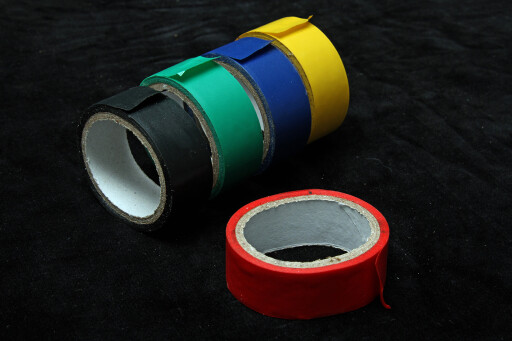 Soldering Iron
Soldering Iron
There are two forms you could consider for a mobile repair kit, a 12-volt unit or a gas unit. Forget the former. They take ages to heat up and the first puff of breeze will blow the heat out of them and they struggle to sufficiently pre-heat a heavier gauge cable ready for soldering. Small gas units are now quite cheap and they can provide instant heat sufficient to solder anything, from heavy duty cable to the finest connections. Don’t forget to carry a can of butane gas to keep it operational.
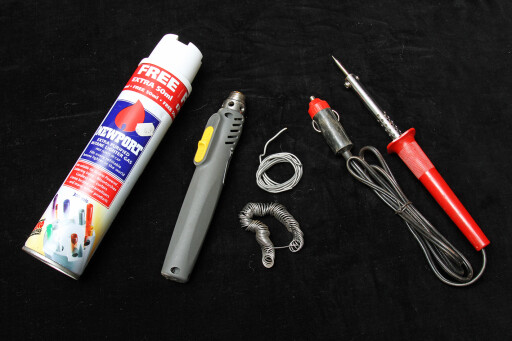 Carry a small roll of solder (thinner gauge material is easier to work with given the variety of wire and component sizes you might need to connect). Practice with it at home to get used to the fairly basic processes of soldering together two lengths of wire or terminal fittings onto a wire. Solder can be added to a crimped fitting (where there’s no insulation) to make it much stronger and more likely to live through the extremes of vibration that it’s going to experience in the outback.
Carry a small roll of solder (thinner gauge material is easier to work with given the variety of wire and component sizes you might need to connect). Practice with it at home to get used to the fairly basic processes of soldering together two lengths of wire or terminal fittings onto a wire. Solder can be added to a crimped fitting (where there’s no insulation) to make it much stronger and more likely to live through the extremes of vibration that it’s going to experience in the outback.
Cable Terminals
Buy a selection of terminals in a variety of types for the most common cable sizes. Make sure you carry ring, spade (or fork), quick disconnect and bullet or butt terminals, and it’s best if they’re pre-insulated as for roadside repairs crimping is usually sufficient.
 A selection in yellow, red and blue insulation will cover the most common cable sizes. Throw in a couple of cable lugs for larger diameter cabling (battery cables, 6B&S for trailer charging cables, etc) and you should be covered.
A selection in yellow, red and blue insulation will cover the most common cable sizes. Throw in a couple of cable lugs for larger diameter cabling (battery cables, 6B&S for trailer charging cables, etc) and you should be covered.
Digital Multimeter
A simple digital multimeter can be worth its weight in gold for diagnosing problems. These can be purchased for as little as $10 and even at that price they will give you a fairly accurate reading. Even just to make you aware of the efficiency of your battery(s), or how your alternator is working, they can vital.
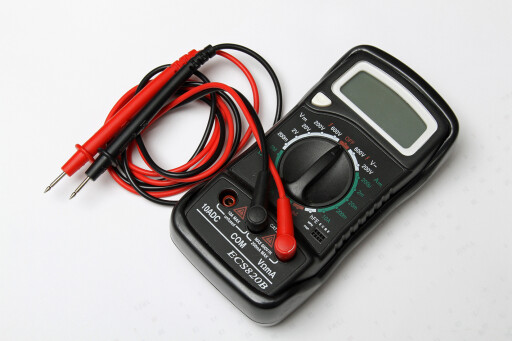 Literature
Literature
If you’re not completely sure of how this all might work we’d recommend one of Collyn Rivers’ excellent books on 12-volt electronics. These will guide you through the basics of all manner of issues in this often complex area in very down-to-earth language. These are available from a variety of outlets or off the internet.

Emergency Fuses
In the absence of a fuse of the right rating, you can fashion one using lengths of single strands of copper wire from your standard 240-volt three-core electrical cable. Each strand from the power or neutral wires (blue and brown), known as 24/0.2 (7.5 amp) or 32/0.2 (10 amp) cable, will function at approximately 8 amps, so two twisted together will equal about 16 amps, three will be approximately 24 amps, and so on.
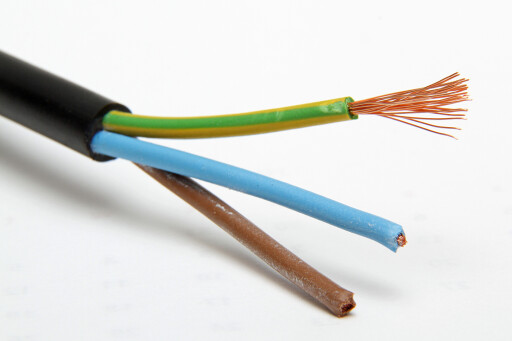 They will not function exactly as manufactured fuses (they will have some internal resistance so may cause things such as lights to run dim) and may take slightly longer to fuse than the manufactured item, but any fuse is better than no fuse at all and it may be enough to get you out of trouble and it has to be better than the nail piece of aluminium foil which some bush electricians are tempted to use. And don’t be tempted to put in lots of strands beyond the original fuse rating if you keep blowing fuses or you may end up with a serious fire.
They will not function exactly as manufactured fuses (they will have some internal resistance so may cause things such as lights to run dim) and may take slightly longer to fuse than the manufactured item, but any fuse is better than no fuse at all and it may be enough to get you out of trouble and it has to be better than the nail piece of aluminium foil which some bush electricians are tempted to use. And don’t be tempted to put in lots of strands beyond the original fuse rating if you keep blowing fuses or you may end up with a serious fire.
Emergency Vice
Sometimes you just need an extra hand, especially when trying to solder wires together. A simple vice can be pulled together from a pair of multigrips or pliers and a rubber band. Simply place the wire in the jaws of the multigrips, wrap the handles with the rubber band and stand it in any horizontal hole, such as the Treg hitch seen here, or in any other position where the set-up is held firmly in place.
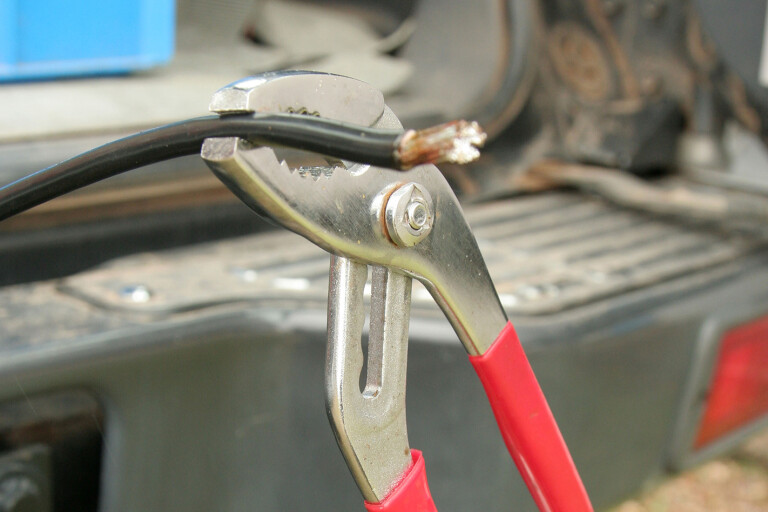

COMMENTS